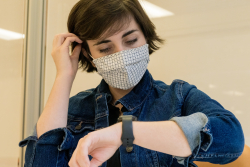Many Americans are simply touching their faces too often during the novel coronavirus pandemic, public health officials have observed, potentially increasing their exposure to the pathogen. But just try to stop.
Face touching is like breathing. We do it without really thinking about it. One pre-pandemic study found that people touch their face an average of 23 times an hour. Even though a finger or hand can pick up the virus on a surface and infect someone while they rub their eyes, mouth or nose, it can seem nearly impossible to avoid such an instinctive act.

But what if a smartwatch beeped or vibrated every time your hand touched your face?
Two University of Florida researchers have launched an effort to build a smartwatch application, or app, that will do just that, essentially training wearers to avoid touching their faces and thus reduce the spread of COVID-19, the disease caused by the coronavirus.
“One way to break the cycle and restrict the spread of the coronavirus or any other respiratory illness is by simply alerting individuals when they try to touch their faces,” said Mamoun Mardini, Ph.D., a faculty member affiliated with the UF Institute on Aging and lead principal investigator of the project.
The hope is that, after being warned repeatedly, users begin conditioning themselves to avoid the behavior altogether.
Mardini, a data scientist who is an assistant professor in the UF College of Medicine’s department of aging and geriatric research, and co-principal investigator Lisa Anthony, Ph.D., an associate professor in the Herbert Wertheim College of Engineering’s department of computer & information science & engineering, received a $20,000, six-month pilot grant from the UF Informatics Institute for their project.
“Even with all the increased scrutiny in people touching their faces during the pandemic, I think we’re all still doing it plenty of times,” said Anthony. “The work is really exciting. It feels nice that we might actually be able to contribute something to a real pressing problem.”
Anthony and Mardini emphasized such an app will prove useful not just in future pandemics, but also during a normal flu season. “It can be used to avoid any respiratory illness,” Mardini said.
Designing an app to accurately detect the movement of hands to face, however, is an extraordinarily complex task. Differentiating someone simply adjusting their glasses, for example, from someone rubbing an eye poses difficult programming challenges.
Anthony and Mardini said they are using 10 volunteers who will be asked to mimic a series of tasks — washing the dishes, using a laptop, eating a snack, repeated face touching, among several — while wearing a smartwatch that will collect data on their movements. Smartwatches contain accelerometers and gyroscopes that detect motion.
“We want them to do really naturalistic behaviors,” Anthony said. “There’s really no wrong way for the users to do the tasks.”
Using that baseline data and artificial intelligence techniques, researchers will design an algorithm they hope will accurately detect hand motions with the sensitivity necessary to separate the scratched nose from an innocent wave to a friend.
Anthony said, “My work focuses on the human-centered approach to computing where we’re really not going to design any algorithm until we understand the human behavior.”
Users will be able to turn the app off, so it won’t go off constantly in a low-risk environment such as the home. Anthony said it is possible a future iteration of the device might use location-based services to turn the app on whenever you leave the house.
If they’re successful, the application would eventually be made available on popular app stores. It’s too early to know when that might occur, said Anthony and Mardini.
Of course, people can touch their face with either hand, and unless they are fanatical watch aficionados, most will be wearing a smartwatch on only one wrist. But Mardini noted research has shown people touch their faces with the nondominant hand 60% of the time.
If someone is left-handed, for example, putting the watch on their right wrist will catch most of their face touches.
A longer-term goal of the project is to determine the effectiveness of such an app. How much can it curtail the undesired face touching?
“We want to know if this will change the behavior of individuals over time,” said Mardini.
This story was originally posted on UF Health.
Check out more stories about UF research on COVID-19.
